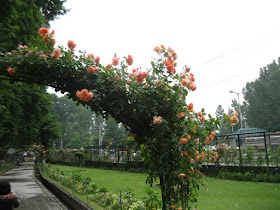After having spent about 2 hours at
Chashme Shahi we had to return taking the same road via the Governor’s residence
(Raj Bhawan). The second largest Mughal garden known as Nishat Bagh was again
located on the main road on the Eastern bank of Dal Lake with the same Zabarwan
mountain ranges as its backdrop. The waters flowing out of the garden has been
made to slide down from about 15 feet high into a rectangular pool by the side
of the road.
Once upon a time the waters straight away fell into the lake but
now there is the road in between. Nishat Bagh literally means a garden of joy or
merriment which was got created by Asif Khan the brother of Noor Jehan (Mughal
Empress) in the year 1633. It is rectangular in shape running some 1800 feet
towards the mountains with a width of over 1100 feet. The mountain slope has 12
terraces, representing the Zodiacal signs. There is a mountain spring at the top
which has been made to flow down through water channels built with polished
stone. There are pools on every segment of the terrace with beautiful fountains.
The entire length of the water channel also has fountains at regular intervals.
There was a large crowd at the ticket
counter and almost all of them were Indians. We too joined them and after
getting our tickets we could gain entry. At the far end there were large Chinar
and Cypress trees. Their number seems to have dwindled and instead a new variety
of flowering trees have come up whith a lotus like large fragrant white flowers
identified as “Magnolia Grandiflora”. They are known as “Him Champa” in
Hindi.
The long water channel with pools and
fountains and flower beds were really a feast to our eyes. Our group members
were not very much inclined to explore all the terraces fully as it seemed that
their earlier visit to Chasme Shahi was very much fulfilling. In fact the upper
reaches are said to be much more beautiful. However, the group as a whole was
not keen to invest more time here and wanted to move to other destinations. It
was some thing like a kind of dictatorship of the proletariat. The majority had
the say.
After having visited Nishat Bagh we
were to visit Shalimar Gardens as per schedule but before we could take our
seats in our vehicles the group members started shouting in unison. The question
was what is going to be there except the same flora and fauna. Sensing
disinclination to visit Shalimar Gardens, our driver said “well I shall take you
to a place which is different and not visited by any one except the locals”. It
was again a garden, couple of decades old and not centuries. The location of
Harwan garden was beneath a dam.
By the time we reached there and came
out of the vehicles, it was drizzling. We procured our entry tickets and got in.
We realized after our entry that what the driver was suggesting was nevertheless
true. There were no outsiders there excepting ourselves and it looked as if this
garden is reserved for Kashmiris. Interestingly we could not come across any of
the locals in the two gardens we visited earlier as if they have developed a
kind of apathy for them. May be they needed seclusion but here we are clearly
encroaching upon their territory.
The garden has neat pathways with
arched gates. There were climbing roses adoring the arches in full bloom and
looked heavenly. The waters from the dam ran through a deep channel on one side
passing through several age old shady Chinar trees. However the leaves
resembled a Maple. The greenery all around captivated us. Several school
children were on a visit that day. There were many girls sitting under a Chinar
tree and singing together. Some Kashmiri families were also enjoying their
picnic lunch.
It was drizzling but unmindful of our
getting wet we climbed up the dam and could enjoy the beautiful view at the far
end though it was a little foggy. The earthen slope of the dam also had a
nursery of rose plants and some of them were also in bloom. Some school girls
ventured to go inside to have a closer look at the flowers. We found that the
girls were keen to have them photographed in their traditional attire. This
facility was being provided by a photographer at the garden.
Yes it was a different experience and
we had the satisfaction of having visited a place which is not frequented by
tourists.
We were hungry and it was time for
lunch too. We moved on and got down in front of a restaurant on the banks of Dal
Lake. Our garden visits thus came to an end.















